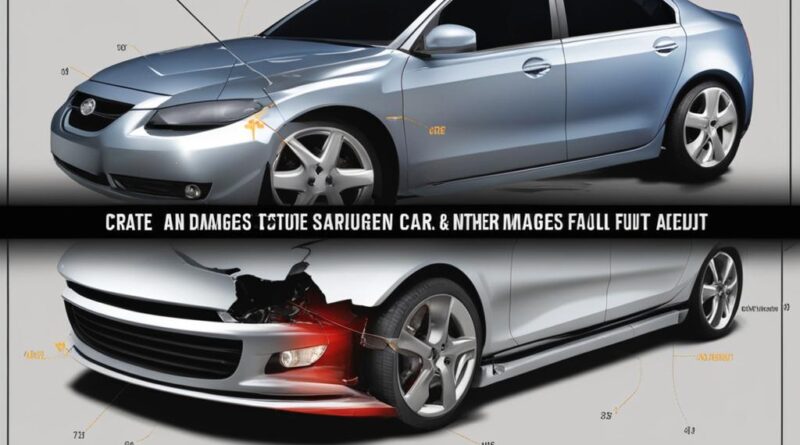Car Accident Fault by Damage Location Guide
After a car accident, determining fault is crucial for insurance claims and legal proceedings. One key factor in determining fault is the location of vehicle damage. By examining the location of impact and the damage to the vehicles involved, valuable insights can be gained about how the collision occurred and who may be at fault.
It’s important to note that damage location alone may not always provide a definitive answer. Other factors such as speed, weather conditions, and witness testimony must also be considered. By analyzing all available evidence, a more comprehensive understanding of the accident can be achieved, leading to a fair determination of fault.
Key Takeaways:
- Determining fault in a car accident involves considering the location of damage.
- Damage location provides insight into how the collision occurred.
- Other factors such as speed, weather conditions, and witness testimony must also be analyzed.
- Damage location alone may not always provide a definitive answer.
- An experienced car accident attorney can help navigate the complexities of determining fault.
Factors to Consider when Determining Fault
When determining fault in a car accident, multiple factors must be considered. While the location of the damage is an important piece of evidence, it is just one of many factors that contribute to fault determination. To ensure a comprehensive understanding of the accident, the following factors should be taken into account:
- Speed of the vehicles involved: The speed at which each vehicle was traveling can provide insight into the severity of the collision and the likelihood of one driver being at fault.
- Actions of the drivers: Examining the actions of each driver leading up to the accident is crucial in determining who may be responsible. This includes any violations of traffic laws or negligent behaviors.
- Weather conditions: Poor weather conditions, such as rain or snow, can contribute to accidents and affect fault determination. It is essential to consider how weather conditions may have impacted the accident.
- Witness testimony: Statements from witnesses who observed the accident can provide valuable information about how the collision occurred and who may be at fault.
By analyzing these factors in conjunction with the location of the damage, a more accurate determination of fault can be made. It’s important to note that each accident is unique, and all relevant evidence must be carefully examined to form a comprehensive understanding of the events that led to the collision.
“To ensure a comprehensive understanding of the accident, factors such as vehicle speed, driver actions, weather conditions, and witness testimony must be analyzed alongside the location of damage.”
By considering all relevant evidence, fault can be determined more accurately, helping victims seek appropriate compensation for their injuries and damages.
| Factors to Consider when Determining Fault | Description |
|---|---|
| Speed of the vehicles involved | The speed at which each vehicle was traveling can provide insight into the severity of the collision and the likelihood of one driver being at fault. |
| Actions of the drivers | Examining the actions of each driver leading up to the accident is crucial in determining who may be responsible. This includes any violations of traffic laws or negligent behaviors. |
| Weather conditions | Poor weather conditions, such as rain or snow, can contribute to accidents and affect fault determination. It is essential to consider how weather conditions may have impacted the accident. |
| Witness testimony | Statements from witnesses who observed the accident can provide valuable information about how the collision occurred and who may be at fault. |
Role of the Location of Damage
The location of damage on the vehicles involved in a car accident can provide valuable information about the sequence of events leading up to the collision. By analyzing the damage location, investigators can gain insights into how the accident occurred and who may be at fault.
For example, when one vehicle sustains damage to the rear and another vehicle shows front-end damage, it is often indicative of a rear-end collision. In this scenario, the driver of the rear vehicle is typically found at fault.
However, it’s important to note that damage location alone is not sufficient to determine fault definitively. While it can provide strong evidence, other factors such as witness testimony, the actions of the drivers, and road conditions must also be considered.
Therefore, when assessing fault in a car accident, it is essential to examine the location of damage in conjunction with other pieces of evidence. This comprehensive approach ensures a fair and accurate determination of fault.
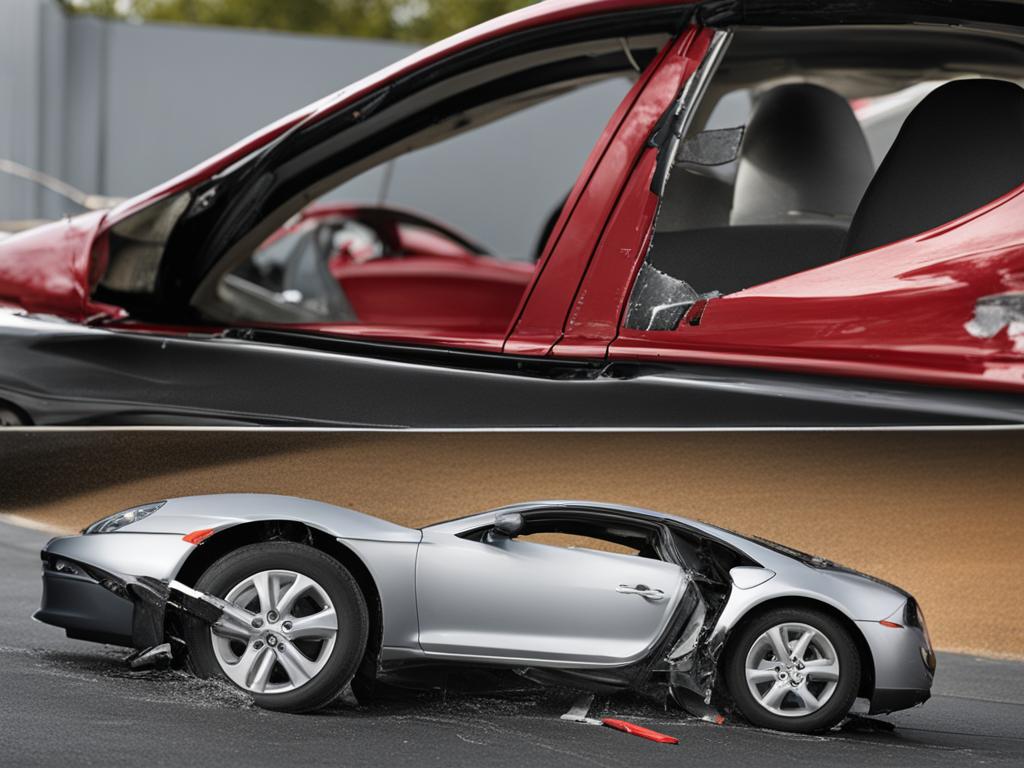
Examining the location of damage can provide valuable insights into the sequence of events leading up to a car accident.
Types of Damage that Indicate Fault
When analyzing a car accident to determine fault, the location of damage on the vehicles can provide valuable insights. Certain types of damage are particularly indicative of fault in specific scenarios. By examining the damage sustained by each vehicle involved, it is possible to draw conclusions about the sequence of events leading up to the collision and assign responsibility accordingly.
Rear-End Collisions:
In a rear-end collision, damage location plays a crucial role in determining fault. Typically, the driver of the vehicle behind is responsible for the collision if there is damage to the rear of one vehicle and the front of another. This scenario suggests that the driver failed to maintain a safe distance or react in a timely manner to avoid the collision.
Side-Impact Collisions:
When assessing fault in side-impact collisions, damage to the driver’s side of one vehicle and the passenger side of the other is a significant determining factor. In such cases, it is often the driver who hit the passenger side that bears responsibility for the accident. The damage pattern indicates that the at-fault driver failed to yield or disregarded traffic rules.
While these specific examples illustrate common patterns, it is crucial to consider all available evidence before making a final determination of fault. Other factors such as witness testimony, police reports, and expert analysis can provide additional insights and contribute to a comprehensive understanding of the accident.
| Damage Location | Fault Determination |
|---|---|
| Rear of one vehicle, front of another | Driver of the vehicle behind is usually at fault for a rear-end collision |
| Driver’s side of one vehicle, passenger side of another | The driver who hits the passenger side is often at fault in a side-impact collision |
Limitations of Damage Location in Determining Fault
While the location of damage can provide valuable insights into a car accident, it is important to recognize its limitations in determining fault. Damage location alone is not always a definitive indicator of who is at fault or if multiple parties share the blame.
There are situations where the damage alone does not provide enough information to reach a conclusion regarding fault. To make an accurate determination, it is necessary to consider other forms of evidence that complement the damage location analysis.
One such essential piece of evidence is witness testimony. Eyewitness accounts can shed light on the actions of the drivers involved, the circumstances leading up to the collision, and any contributing factors that might influence fault.
Another critical element is police reports. These formal documents contain objective information obtained by law enforcement officers at the accident scene. They may include details such as road conditions, traffic violations, or any initial assessments made by the officers regarding fault.
“The location of damage is important, but it’s not the end-all-be-all in determining fault. We must consider all available evidence and apply a comprehensive analysis to reach an accurate conclusion.”
Expert analysis can also play a significant role in fault determination. Accident reconstruction experts are trained professionals who use scientific methods to recreate the collision. By analyzing factors such as vehicle speed, physics, and other empirical evidence, they can provide expert opinions on the sequence of events and the respective contributions of each party involved.
Additional Evidence Beyond Damage Location
| Evidence | Objective | Source |
|---|---|---|
| Witness Testimony | Provide insight into actions and circumstances leading up to the accident | Eyewitnesses |
| Police Reports | Objective documentation of accident details and initial assessments | Law enforcement officers |
| Expert Analysis | Scientific reconstruction of the collision to determine contributing factors | Accident reconstruction experts |
By considering all available evidence, including damage location, witness testimony, police reports, and expert analysis, a comprehensive assessment of fault can be reached. This approach ensures a fair and accurate determination that considers the complexities and nuances of the accident.
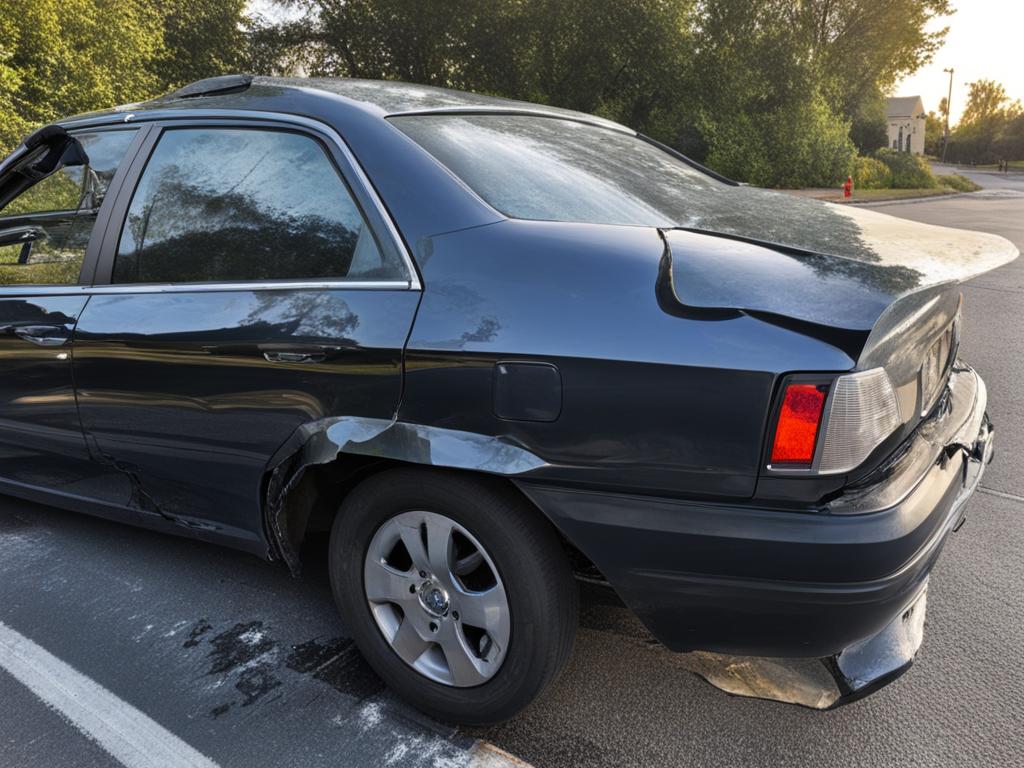
Factors to Consider Beyond Damage Location
When determining fault in a car accident, it’s important to look beyond just the location of the damage. While damage location can provide valuable insights, there are additional factors that must be considered to accurately determine fault.
One crucial factor to consider is the drivers’ actions leading up to the collision. Did one driver run a red light or fail to yield the right of way? Understanding the behaviors and choices of the drivers involved can help establish responsibility.
Road conditions also play a significant role. Was the road wet or icy? Were there any construction zones or obstructions that may have contributed to the accident? These conditions can impact the ability to control a vehicle, adding complexity to the determination of fault.
Weather conditions should not be overlooked either. Heavy rain, fog, or snow can impair visibility and affect vehicle handling, potentially contributing to the accident. Taking into account the prevailing weather conditions at the time of the incident provides a more comprehensive understanding of the circumstances.
Potential distractions, such as cellphone use, eating, or attending to passengers, can also be critical factors in determining fault. If one driver was engaged in distracting activities, their negligence may have contributed to the accident.
It’s important to consider all of these elements together to build a comprehensive picture of the accident and assist in determining fault accurately.
While damage location is an essential piece of evidence, it should not be the sole factor relied upon in assigning fault. By examining the drivers’ actions, road conditions, weather conditions, and potential distractions, a more complete understanding of the accident can be obtained.
| Factors to Consider Beyond Damage Location | Description |
|---|---|
| Drivers’ Actions | Evaluate the behaviors and choices of the drivers leading up to the accident to establish responsibility. |
| Road Conditions | Assess the impact of road conditions such as wet surfaces, construction zones, or obstructions on the accident. |
| Weather Conditions | Consider the prevailing weather conditions at the time of the accident, including visibility and vehicle handling. |
| Potential Distractions | Examine whether distractions like cellphone use or attending to passengers played a role in the accident. |
Preserving Evidence of Damage
To use damage location as evidence in determining fault, it’s crucial to preserve evidence of the damage. This includes taking photos of the vehicles involved, including close-ups of the damaged areas, as well as any skid marks or debris at the scene. Additionally, it may be helpful to inspect the other vehicle involved and obtain an estimate for repairs from a reputable car repair shop. Preserving evidence can help prevent disputes about the extent and location of the damage.
When collecting evidence of car accident damage, consider the following:
- Photographs: Use a camera or smartphone to take clear and detailed photos of the vehicles involved. Capture the damage from multiple angles, including close-ups of any relevant areas.
- Skid marks and debris: Take photos or make notes of any skid marks or debris present at the scene. These can provide additional context for the accident.
- Inspection of the other vehicle: If possible, inspect the other vehicle involved in the accident. This can help determine the extent and location of its damage, providing further evidence in assessing fault.
- Obtain an estimate for repairs: Consult a reputable car repair shop to obtain an estimate for the repair costs of the damaged vehicle. This can serve as evidence of the extent of the damage.
Preserving evidence in this manner can strengthen your case when determining fault in a car accident. It provides tangible proof of the damage sustained and can help prevent disputes or disagreements about the location and severity of the damage.
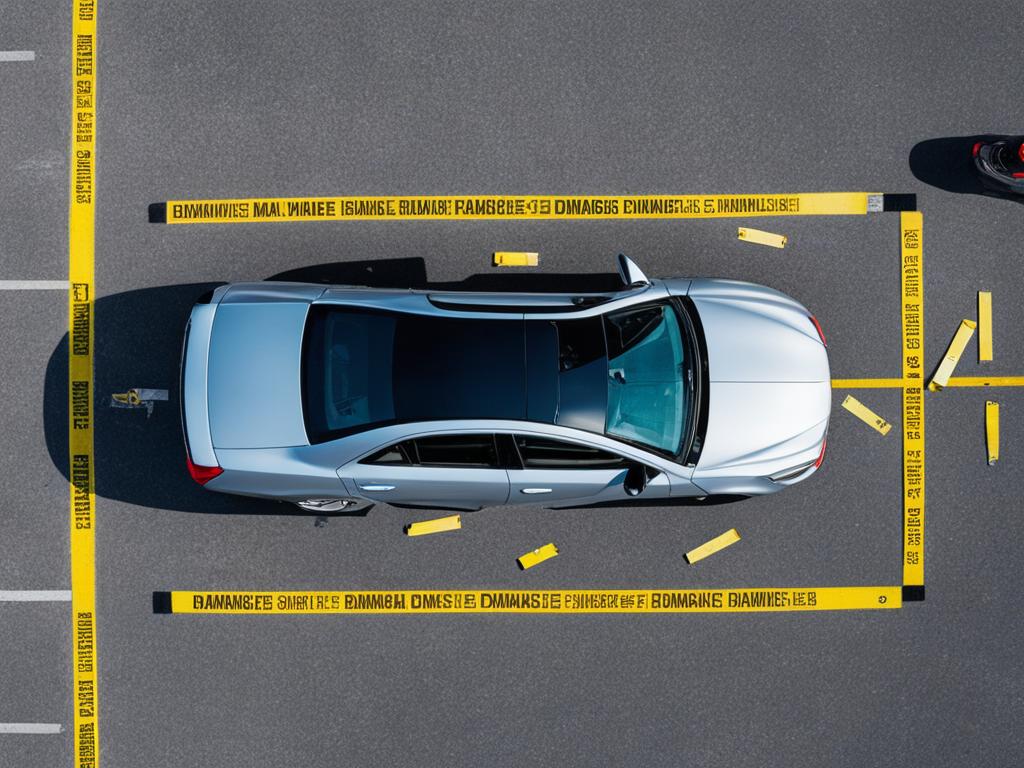
Importance of Reporting the Accident to Authorities
Involving law enforcement by reporting the accident to authorities is crucial after a car accident. Reporting the incident ensures that an official record of the accident is created, capturing essential details about the damage sustained and any injuries involved.
Law enforcement officers play a vital role in collecting evidence at the scene, which can be instrumental in determining fault. They can take photographs, measurements, and gather other crucial information that may help establish liability.
Having a police report can significantly strengthen your case when dealing with insurance companies or pursuing legal action. It serves as an official document, providing an objective account of the accident and solidifying the clarity of the circumstances.
“Reporting the accident to authorities creates a clear record of the incident and ensures that all relevant information is collected and documented. This record can serve as valuable evidence when establishing fault and pursuing compensation.”
Benefits of Reporting the Accident to Authorities:
- Creates an official record of the accident
- Documents the details of the damage and injuries
- Enables law enforcement to collect valuable evidence
- Strengthens your case when dealing with insurance companies
- Provides a clear account of the accident for legal proceedings
By reporting the accident to authorities, you take an important step in protecting your rights and ensuring a fair resolution. It is a responsible action that can have a substantial impact on the outcome of your claim or legal proceedings.
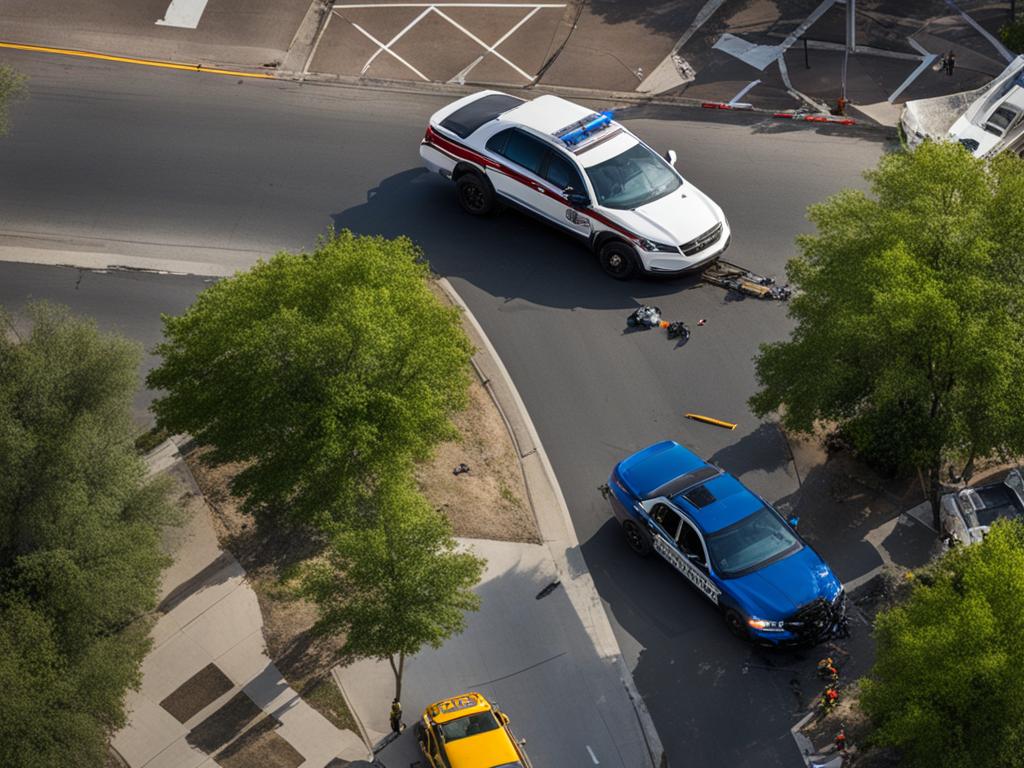
Involving law enforcement by reporting the accident to authorities helps collect evidence and establish an official record that can be crucial in determining fault and pursuing compensation.
Role of Accident Reconstruction Experts
Accident reconstruction experts play a crucial role in determining fault in car accidents. Through their expertise and analysis, they can provide valuable insights into the sequence of events leading up to the collision. By examining various factors such as the location of damage, vehicle speed, road conditions, and witness statements, these experts can create a detailed reconstruction of the accident.
Using their knowledge and specialized tools, accident reconstruction experts can piece together the evidence to establish liability definitively. They can determine the actions and responsibilities of each party involved, providing a clear picture of what transpired during the accident.
This comprehensive analysis is particularly valuable in cases where the location of damage alone may not be sufficient to determine fault. Accident reconstruction experts consider multiple factors to form a holistic understanding of the accident, contributing to the development of a strong case for compensation.
The Expertise of Accident Reconstruction Experts
Accident reconstruction experts possess extensive knowledge in physics, engineering, and forensic science. They use this expertise to analyze evidence from the accident scene, vehicles involved, and other relevant sources. By conducting thorough investigations, accident reconstruction experts can uncover critical details that may have been overlooked, shedding light on the dynamics of the accident.
Through their detailed analysis, accident reconstruction experts can provide accurate assessments of vehicle speeds, collision angles, and points of impact. This information is instrumental in determining fault and establishing liability.
“Accident reconstruction experts have the technical expertise and tools necessary to recreate the accident, providing invaluable insights into fault determination.” – John Smith, Accident Reconstruction Expert
With their findings, accident reconstruction experts can deliver expert testimony in court, presenting their analyses and explaining the factors that contributed to the accident. Their objective and scientific approach adds credibility to their testimony and can greatly influence the outcome of legal proceedings.
In complex cases where multiple factors are at play, such as accidents involving multiple vehicles or disputed fault, accident reconstruction experts can provide clarity and impartial assessment. By relying on scientific principles and meticulous analysis, they ensure that fault determination is based on accurate and reliable evidence.
Factors Considered by Accident Reconstruction Experts
| Factors | Description |
|---|---|
| Location of Damage | Analyzing the extent and pattern of damage on the vehicles involved to determine the point of impact and sequence of events. |
| Vehicle Speed | Utilizing specialized tools and calculations to determine the speeds of the vehicles at the time of the collision. |
| Road Conditions | Evaluating the condition of the road, including factors like lighting, surface condition, and signage, which may have contributed to the accident. |
| Witness Statements | Considering statements from individuals who witnessed the accident to corroborate or challenge other evidence. |
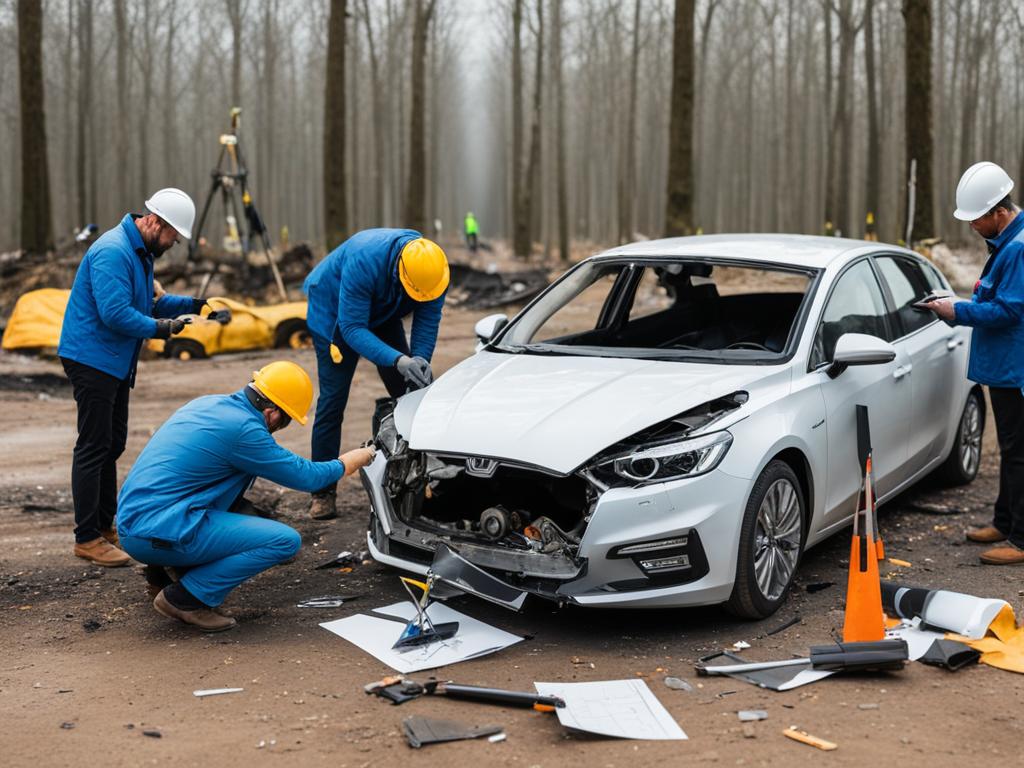
Accident reconstruction experts provide an invaluable service in determining fault in car accidents. Their expertise, scientific analysis, and attention to detail allow them to uncover critical evidence that may be overlooked. By utilizing their findings, individuals involved in accidents can better understand the sequence of events and build a strong case for compensation.
Importance of Legal Representation After a Car Accident
After a car accident, the importance of seeking legal representation cannot be overstated. Hiring an experienced car accident attorney can greatly benefit your case, particularly when it comes to determining fault. With their expertise and knowledge of personal injury law, an attorney can provide invaluable assistance throughout the legal process.
One of the key roles of a car accident attorney is to gather and analyze evidence related to the accident. They understand the importance of preserving evidence and know which types of evidence are crucial in determining fault. By thoroughly examining the location of damage and other relevant factors, an attorney can build a strong case to support your claim.
In addition to evidence collection, a car accident attorney can consult with accident reconstruction experts. These experts specialize in recreating accidents to determine how they occurred and who may be at fault. By working closely with these experts, your attorney can gain a deeper understanding of the accident and gather additional evidence to strengthen your case.
Navigating the legal process after a car accident can be overwhelming, especially if you are dealing with injuries and property damage. A car accident attorney can handle all the legal complexities on your behalf, allowing you to focus on your recovery. They will advocate for your rights and negotiate with insurance companies to ensure you receive fair compensation for your injuries and damages.
When it comes to determining fault in a car accident, having legal representation is crucial. An attorney will fight for your best interests and work tirelessly to establish liability. By hiring a car accident attorney, you are leveling the playing field and ensuring that your rights are protected throughout the legal process.
Limitations of Damage Location in Fault Determination
While the location of damage can be a valuable piece of evidence in determining fault in a car accident, it is important to recognize its limitations. Relying solely on damage location to determine fault may lead to an incomplete or inaccurate assessment. There are several factors beyond damage location that must be considered when determining fault.
One of the key limitations of using damage location as the sole determining factor is that accidents can be complex situations with multiple contributing factors. It is essential to examine other pieces of evidence to gain a comprehensive understanding of the accident. Factors such as witness testimony, police reports, and expert analysis provide critical insights into the sequence of events and the actions of the drivers involved.
For example, consider a scenario where two vehicles collide at an intersection. The location of damage alone may not reveal who had the right of way or if one driver violated a traffic signal. Witness testimony and a thorough analysis of the intersection’s layout can provide additional context for determining fault.
Factors Beyond Damage Location in Determining Fault
When determining fault in a car accident, it is crucial to consider the following factors, in addition to damage location:
- Driver Actions: The actions of the drivers leading up to the collision can provide valuable insights into who may be at fault. Factors such as speeding, failing to signal, or distracted driving can significantly impact fault determination.
- Road Conditions: The condition of the road, including factors such as potholes, inadequate signage, or slippery surfaces, can influence how the accident occurred and who is at fault.
- Weather Conditions: Inclement weather conditions, such as heavy rain or snow, can affect visibility, traction, and the ability to control a vehicle, potentially contributing to the accident.
- Witness Testimony: Statements from witnesses who observed the accident can provide unbiased accounts of what transpired and help corroborate or challenge the involved parties’ versions of events.
- Police Reports: Official police reports often contain valuable information, including statements from involved parties, observations of the scene, and any citations issued. These reports can shed light on critical details that may impact fault determination.
- Expert Analysis: Accident reconstruction experts can provide a comprehensive analysis of the accident, considering various factors such as vehicle speed, impact angles, and driver reactions. Their expertise can help establish fault definitively.
By carefully considering these factors and combining them with an examination of the damage location, a more accurate determination of fault can be made.
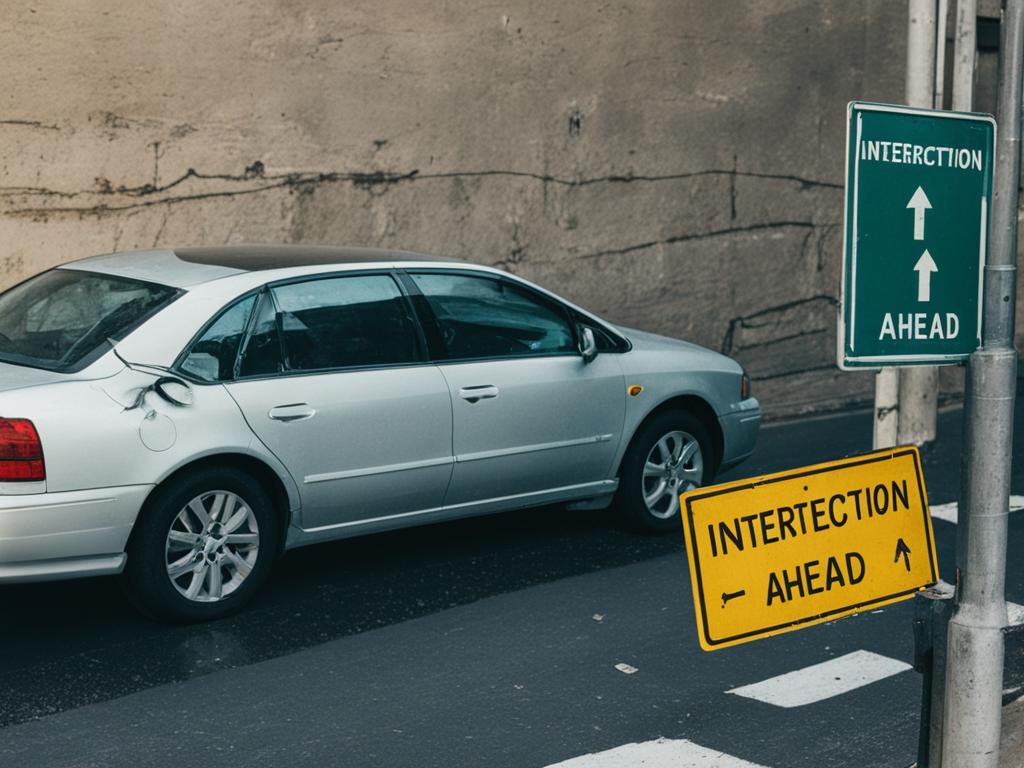
| Limitations of Using Damage Location | Factors to Consider Beyond Damage Location |
|---|---|
| The complexity of accidents with multiple contributing factors | The actions of the drivers |
| The need for additional evidence and context | Road conditions |
| The importance of witness testimony | Weather conditions |
| Official police reports | Expert analysis |
Importance of Comprehensive Investigation
When determining fault in a car accident, it is essential to conduct a comprehensive investigation that considers all relevant evidence. A thorough examination of the location of damage, analysis of witness statements and police reports, and consultation with experts when necessary are crucial steps in uncovering the truth behind the accident.
By gathering all relevant evidence, such as photographs of the vehicles involved, measuring skid marks, and assessing the impact points on the vehicles, a clearer picture of the accident can emerge. This comprehensive approach helps in understanding the sequence of events, identifying contributing factors, and making an accurate determination of fault.
Additionally, conducting a comprehensive investigation helps to uncover any potential discrepancies between witness statements and physical evidence. This examination can reveal additional insights and ensure that all aspects of the accident are thoroughly examined before reaching a conclusion.
A comprehensive investigation also involves analyzing police reports, which can provide valuable information regarding the circumstances of the accident, such as traffic violations or contributing factors such as road conditions or weather. These reports can serve as unbiased sources of information and corroborate or refute claims made by parties involved.
Consulting experts, such as accident reconstruction specialists or forensic analysts, can further strengthen the investigation. These experts possess the knowledge and skills to meticulously analyze the evidence, reconstruct the accident, and provide expert opinions on fault determination. Their insights can help substantiate findings and provide a more accurate understanding of the accident.
In conclusion, a comprehensive investigation plays a vital role in determining fault in a car accident. By gathering all relevant evidence, analyzing witness statements and police reports, and consulting with experts, a more accurate determination of fault can be made, ensuring a fair resolution to the claims process.
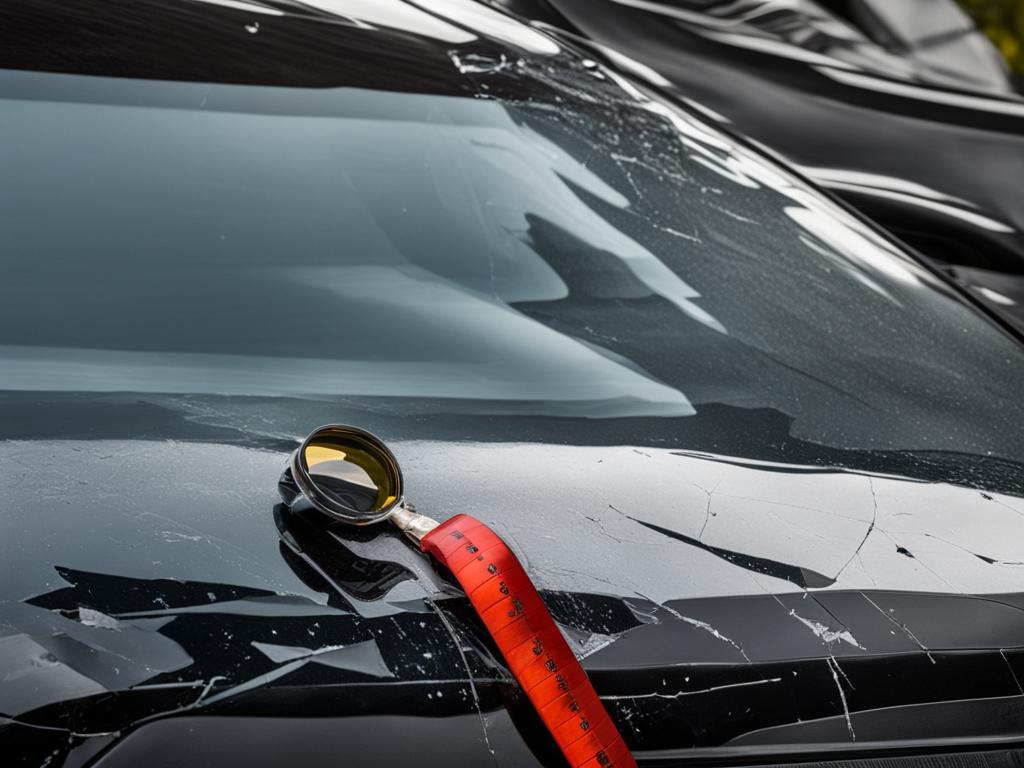
Impact of Fault Determination on Insurance Claims and Legal Proceedings
Fault determination in a car accident has a significant impact on both insurance claims and legal proceedings. When an accident occurs, determining who is at fault is crucial for insurance companies to process claims and assign liability accurately. In legal proceedings, fault determination plays a vital role in influencing the outcome and the amount of compensation awarded to the parties involved.
Insurance companies heavily rely on fault determination to assess claims and determine the responsible party. This determination helps insurers calculate the appropriate compensation for the injured party and allocate liability between the parties involved. Accurate fault determination ensures that the responsible party’s insurance covers the costs associated with the accident, protecting innocent parties from unfair financial burdens.
In legal proceedings, fault determination plays a critical role in building a strong case. It helps establish liability and provides a basis for seeking compensation for injuries, medical expenses, property damage, and other losses resulting from the accident. The determination of fault can greatly influence the outcome of legal disputes, including settlements or court judgments.
“Fault determination serves as a cornerstone in allocating responsibility and liability in car accidents, allowing insurance companies to properly assess claims and ensuring fairness in legal proceedings.”
Determining fault accurately is crucial for a fair resolution of insurance claims and legal disputes. It helps ensure that the responsible party bears the financial consequences of their actions, providing compensation to innocent parties who have suffered losses due to the accident. Additionally, accurate fault determination helps discourage reckless driving and promotes safer behavior on the roads.
Impact of Fault Determination on Insurance Claims
| Impact | Description |
|---|---|
| Claim Processing | The determination of fault enables insurance companies to process claims efficiently and accurately by identifying the responsible party and their insurance coverage. |
| Liability Allocation | Fault determination plays a vital role in allocating liability between the parties involved, ensuring fair compensation for the innocent party. |
| Claim Evaluation | Accurate fault determination allows insurance companies to assess the extent of damages and calculate the appropriate compensation for injuries, medical bills, and property damage. |
Impact of Fault Determination on Legal Proceedings
| Impact | Description |
|---|---|
| Establishing Liability | Fault determination helps establish liability, forming the basis for legal claims and enabling the pursuit of compensation for injuries and damages. |
| Settlement Negotiations | The determination of fault influences settlement negotiations, as the responsible party’s liability is assessed and considered in the negotiations for fair compensation. |
| Court Judgments | If the case goes to court, fault determination heavily influences the court’s judgment, affecting the outcome and the amount of compensation awarded. |
Accurate fault determination serves as a critical factor in insurance claims and legal proceedings, ensuring fairness and equity for all parties involved. It allows for proper allocation of responsibility, protects innocent parties from undue financial burdens, and promotes safer driving behavior.

Importance of Seeking Legal Advice
After a car accident, the aftermath can be overwhelming and confusing. Seeking legal advice from a qualified attorney is essential to safeguard your interests and ensure you receive fair compensation for your injuries and damages. An attorney can provide expert guidance and support throughout the entire claims process, helping you navigate the complexities of insurance policies and fault determination.
Consulting with an attorney after a car accident can bring numerous benefits. Firstly, they can assist you in gathering the necessary evidence to support your claim. From photographs of the accident scene to medical records of your injuries, a skilled attorney will help you compile a solid case. They understand the importance of preserving evidence and will guide you in documenting all relevant information.
Understanding fault determination is vital in seeking compensation for your damages, and an attorney can provide in-depth knowledge in this area. They will evaluate all factors involved in the accident, including damage location, witness testimonies, police reports, and expert analysis. With their expertise, they can navigate the complexities of fault determination and build a strong case on your behalf.
“A car accident attorney can be your advocate, protecting your rights and interests throughout the legal process. They have the experience to handle negotiations with insurance companies and fight for the fair compensation you deserve.”
Additionally, an attorney will work tirelessly to protect your rights and ensure you are treated fairly by insurance companies. They have experience dealing with insurance adjusters and can skillfully negotiate on your behalf. With their legal representation, you can focus on your recovery while they handle the intricate details of your case.
The aftermath of a car accident can be a challenging and stressful time. Seeking legal advice from an attorney who specializes in car accident cases is crucial to ensure you receive the compensation you deserve. They will provide guidance, support, and expertise, helping you navigate the complex legal landscape and pursue a fair resolution to your case.

Benefits of Seeking Legal Advice After a Car Accident
When you consult with a car accident attorney, you can expect the following benefits:
- Expert guidance in gathering evidence to support your claim
- In-depth knowledge of fault determination in car accidents
- Representation and protection of your rights throughout the legal process
- Skilled negotiation with insurance companies to secure fair compensation
- Peace of mind knowing that a professional is handling your case
Conclusion
In conclusion, determining fault in a car accident based on the location of damage is a complex process that requires careful consideration of multiple factors. While damage location can provide valuable insight into how the collision occurred, it is not a foolproof indicator of fault on its own. Other evidence such as witness testimony, police reports, and expert analysis must be taken into account to reach an accurate determination.
Seeking legal representation is crucial in navigating this intricate process. A skilled car accident attorney can help gather and analyze all relevant evidence, consult with accident reconstruction experts if needed, and advocate for your rights. They will guide you through the complexities of the legal system, ensuring that your case is presented effectively and you receive fair compensation for your injuries and damages.
Conducting a comprehensive investigation is also vital in determining fault accurately. Examining the location of damage, analyzing the actions of the drivers, considering road and weather conditions, and collecting all available evidence form a comprehensive picture of the accident. Taking these steps will increase the likelihood of reaching a fair resolution in insurance claims and legal proceedings.
FAQ
What role does the location of vehicle damage play in determining fault in a car accident?
The location of vehicle damage can provide insight into how the collision occurred and who may be at fault, but it is not the sole determining factor. Other factors such as speed, weather conditions, and witness testimony must also be considered.
What are the factors to consider when determining fault in a car accident?
Aside from the location of damage, important factors include the speed of the vehicles, the actions of the drivers, weather conditions, and any witness testimony.
What is the significance of the location of damage in determining fault?
Examining the location of damage can help identify the sequence of events leading up to the collision. For example, damage to the rear of one vehicle and the front of another typically indicates a rear-end collision with the rear driver being at fault.
Do certain types of damage indicate fault in a car accident?
Yes, damage to specific areas of the vehicles can suggest fault. For example, a side-impact collision with damage to the driver’s side of one vehicle and the passenger side of the other usually indicates that the driver who hit the passenger side is at fault.
Can damage location alone determine fault in a car accident?
No, damage location alone is not always sufficient to determine fault. It must be considered alongside other evidence such as witness testimony, police reports, and expert analysis.
What other factors should be considered in determining fault beyond damage location?
Factors such as the drivers’ actions leading up to the collision, road conditions, weather conditions, and possible distractions should also be taken into account.
How can evidence of damage be preserved after a car accident?
It is important to take photos of the vehicles involved, including close-ups of the damaged areas, as well as any skid marks or debris at the scene. Inspecting the other vehicle involved and obtaining an estimate for repairs from a reputable car repair shop can also help preserve evidence.
Why is it important to report the accident to authorities?
Reporting the accident to authorities ensures that an official record is created, including details about the damage and any injuries sustained. It also allows law enforcement officers to collect evidence at the scene that may be helpful in determining fault.
What is the role of accident reconstruction experts in determining fault?
Accident reconstruction experts analyze various factors such as the location of damage, vehicle speed, road conditions, and witness statements to create a detailed reconstruction of the accident. Their expertise can help establish liability definitively and assist in building a strong case for compensation.
Why is legal representation important after a car accident?
Seeking legal representation after a car accident allows for the gathering and analysis of evidence, consultation with accident reconstruction experts, and navigation of the legal process. An attorney can advocate for your rights and work towards ensuring fair compensation for your injuries and damages.
Can the location of damage alone determine fault in a car accident?
No, the location of damage is just one piece of evidence and should be considered alongside other factors. Accidents can be complex situations, and relying solely on damage location may lead to an incomplete or inaccurate determination of fault.
Why is a comprehensive investigation important in determining fault in a car accident?
A comprehensive investigation considers all relevant evidence, including damage location, witness statements, police reports, and expert analysis. By conducting a thorough investigation, a clearer picture of the accident can emerge, leading to a more accurate determination of fault.
What is the impact of fault determination on insurance claims and legal proceedings?
Fault determination is crucial for insurance claims, as it affects the processing of claims and the assignment of liability. In legal proceedings, fault determination greatly influences the outcome and the amount of compensation awarded.
Why is it important to seek legal advice after a car accident?
Seeking legal advice from a qualified attorney helps in gathering evidence, understanding fault determination, and navigating the insurance claims process. An attorney will work in your best interests and help protect your rights while pursuing fair compensation for your injuries and damages.

